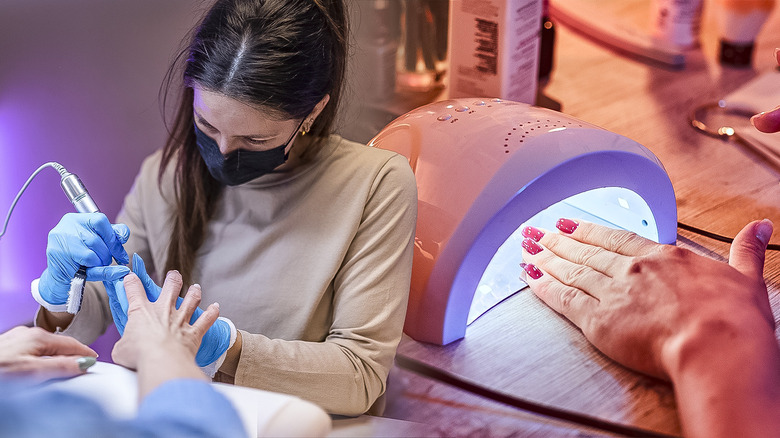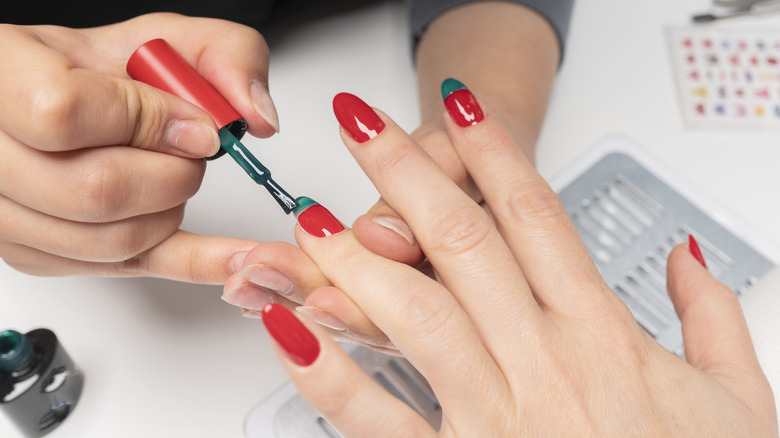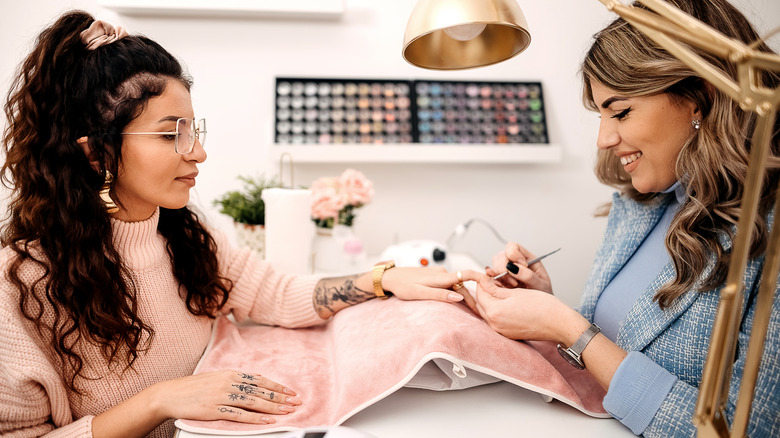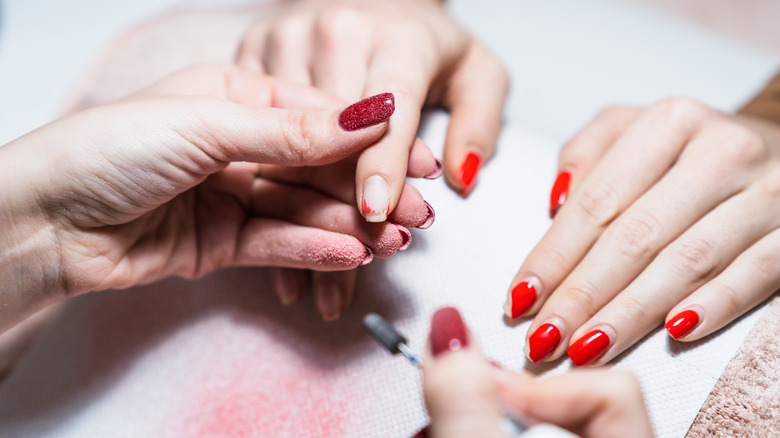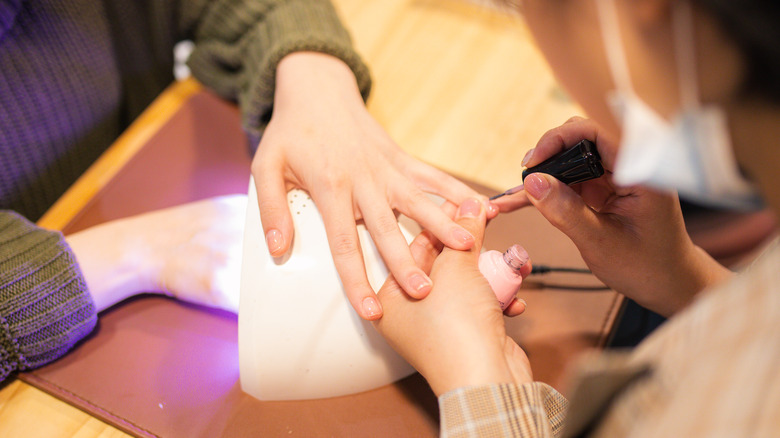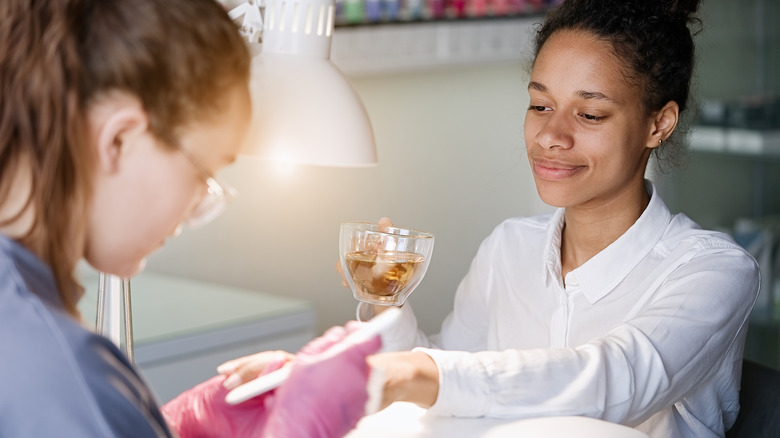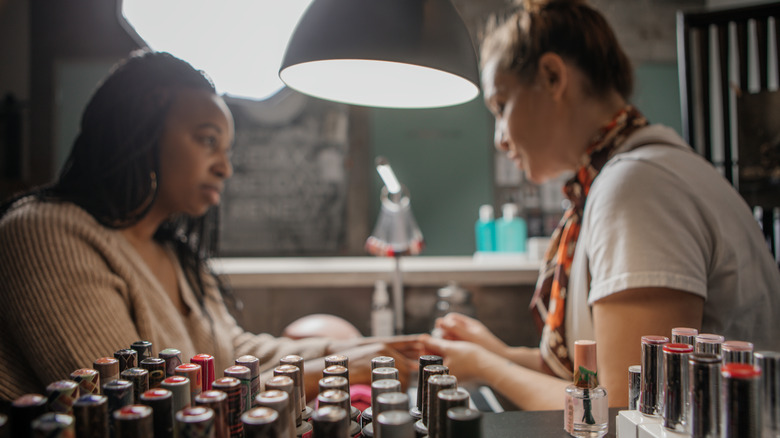The Biggest Mistakes You're Probably Making At The Nail Salon (And What To Do Instead)
Getting a manicure or pedicure is one of life's truest luxuries. It's something we all can enjoy, no matter our gender, sexual orientation, or age, as it allows us to relax and check out of our day-to-day activities for a bit. It also gives those of us lacking a steady hand the opportunity to get a mani or pedi that's neatly and professionally done.
But, while going to the nail salon is meant to be a relaxing event — and it usually is — plenty of mistakes can be made, especially when you don't speak up to the technician. It's your job to let the tech know your preferences, your possible allergies, and your expectations. It's also up to you to take preventative measures where necessary to protect yourself from any of these red flags. Although you may make some major mistakes while at the nail salon, this doesn't mean you can't change your ways and be better going forward.
Skipping the base coat
First of all, nail prep is key before getting any services done at a nail salon. Regardless of the type of mani or pedi, the tech should clean, shape, and ready your nails before diving into drilling, polishing, or anything else for that matter.
One essential step is getting a base coat. If you think of a manicure like building a house, the base coat is the foundation on which the entire manicure relies. It not only protects the nail from polish stains, but its adhesive nature also makes your manicure last longer. "You have to have a base coat!" celebrity nail technician Gloria Williams tells Insider. "Regular polish or gel polish, if they go to polish your toenails with no base coat, that's it. And they're doing it so you come back and spend more money."
If your technician tries to skip it, politely request it. You're paying for this service, so you're more than within your right to get the most out of your mani or pedi.
Not positioning your hand correctly
Believe it or not, there's actually a right and wrong way to position your hands (and feet!) at the nail salon. You may think that the salon setup is done in a lackadaisical way, but it's actually set up with both the nail tech and clients in mind. As a client, your hand should be directly in front of the nail tech. Your hand should be limp, and your wrist should rest comfortably on the ergonomic pad. This prevents the tech from having to twist in awkward ways to accommodate you or having to bear the entire weight of your limbs.
If the tech adjusts your position a bit, don't fight them on it. You may be there to relax, but being rude to your manicurist isn't cool. Your nail tech probably works multiple-hour shifts, so show them respect for their physical and psychological health. Whether you're getting a manicure or pedicure, always follow the tech's lead regarding the positioning of your hands or feet.
Drilling natural nails
As much as you may want to put everything in the hands of your nail tech, they occasionally make choices you should question. One is drilling natural nails. "Hands-down, never let a manicurist remove soft gel polish with a drill," manicurist Mabelyn Martin tells Insider, explaining that nail salons do this practice because it saves them time from having clients soak their nails in polish remover, which is the correct procedure. She adds, "If you know you don't have acrylic nails and someone is using a drill to remove your polish, that's not a salon I would go back to."
When natural nails are drilled, it damages them to the point where gel polish can seep into the nail plate. This not only makes removing the polish more difficult each time, but it also denigrates the integrity of the nail itself. If your nails are natural, and the tech pulls out the drill, politely remind them that you don't have acrylic nails.
Overlooking the potential dangers of UV curing lamps
Although we know that UV rays from the sun cause damage to the skin, not everyone realizes that UV rays from the gel curing machine may also present a potential risk. According to a 2023 study published in Nature Communications, the UV rays used in these curing machines can increase the risk of skin cancer with prolonged use because of the damage they cause to DNA and their contribution to cell mutation.
"UV light in our environment and UV light for tanning beds is known to increase our risk of skin cancer, including melanoma, the most deadly form of skin cancer, as well as squamous and basal cell skin cancers," board-certified dermatologist Caren Campbell tells Teen Vogue. "These studies likely keep popping up because the public keeps using them. We already know it, but the more evidence we have that it is, in fact, true, the more we hope the public will listen and protect themselves."
So, how do you protect yourself? Sunscreen. That's right. Just lather up your hands before getting a manicure. You can also opt for gloves with the fingertips cut off so your hands are protected but your polish is cured. Or you can forgo gel manicures altogether. It's up to you.
Reusing tools
Nail salon tools should never be reused. Even if your nail tech has a jar full of tools sitting in disinfectant, it's still not good enough. As celebrity nail technician Gloria Williams tells Insider, if you see such a jar, it's a bad sign. She explains that "[tools] should come from a packet — a sanitized packet." Another option is to sterilize tools in a sanitizing machine that reaches over 320°F (160°C).
It's important to remember that if the tools were used on someone before you and they're not properly sanitized, you can very easily catch whatever fungus or bacterial infection the previous person might have. Your best bet for staying 100% free of bacteria is to get your own nail kit to bring with you to the salon. "There's no harm or shame in bringing your own," celebrity manicurist and nail spa owner Skyy Hadley tells Glamour. "Stay away from shared foam blocks, buffers, or any non-metal tool."
Failing to notice a lack of cleanliness
The biggest mistake made of all at the nail salon is ignoring any unsavory attempts at cleanliness. All work stations should be wiped clean, towels should be changed for each client, foot baths for pedicures should be lined with plastic bags, and dust should be nonexistent. "We all go into those corner nail salons, and there's dust everywhere — on tables, in drawers," celebrity manicurist Deborah Lippmann tells Refinery 29. "That's stuff from other people's nails." Yikes.
While a dirty nail salon isn't the end of the world, it's still something to avoid. If you walk into a place without proper ventilation, clean floors, spotless workstations, or towels that have clearly never seen bleach or boiling water, you should leave. Just because you walked in doesn't mean you're obligated to stay. The only person you're obligated to is yourself, which means staying healthy and safe.
